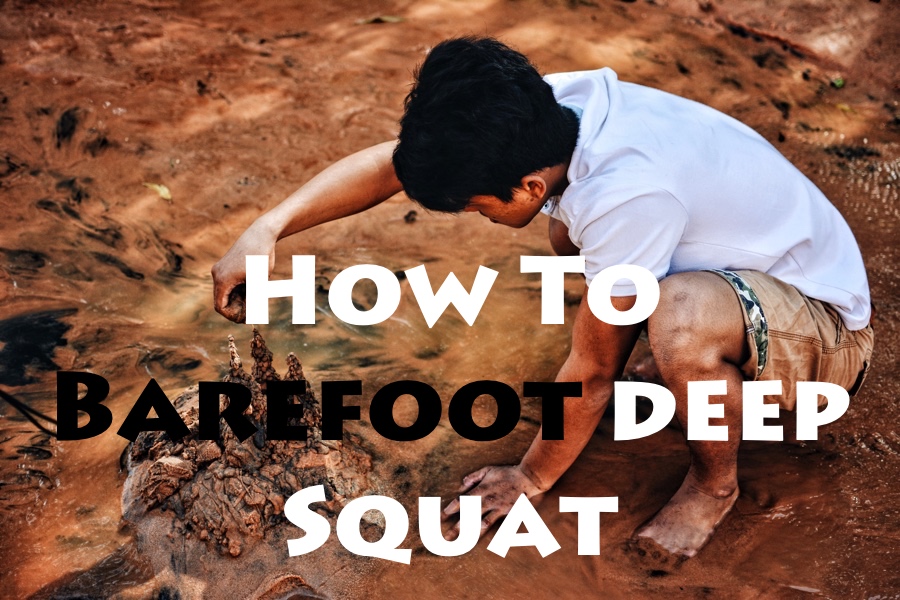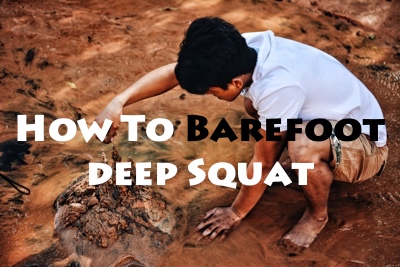
The Barefoot Deep Squat in action (Photo by Pengsheng Guo on Unsplash)
How To Barefoot Deep Squat
Table of Contents
I was online recently and there was an image of a little child doing the barefoot deep squat and playing with some other children. I immediately got caught by the effortless ease with which children can squat to that level of depth. So I did some research to come up with the answer to this:
How To Barefoot Deep Squat: To perform the Barefoot Deep squat you need a combination of things all working at the same time. Start with amazingly supple ankles, hips, knee, flexibility and suppleness quite like that of a little child. Lastly, practice practice practice, 30 mins a day is a good target to set.
So let’s pull together all the elements you will need to make it happen.
Firstly let’s look at Barefoot Deep Squatting from the top down.
How To Barefoot Deep Squat (BDS)?
The setup for the BDS looks simple.
- You set your feet a bit wider than shoulder-width apart and pointing straight ahead.
- Aim for equal weight distribution of your feet, with your heels on the ground and weight distributed over the arch.
- Majority of your weight should be on the balls of your feet.
- You will have to lower your rib cage and hold a neutral spine.
- When you get into the Squat, you don’t want your knees to move forward or your back to arch. Just drop your butt straight down.
- As you squat, you want your knees over your pinky toes if you can.
- Keep a neutral spine throughout the movement.
- Most importantly strive to relax in that position as best you can.
Getting into position to do the BDS may prove to be a challenge initially but don’t worry it happens to all of us after years of sitting upright in chairs.
The best-suggested approach is to find a solid anchor point to hold onto to get into position the edge of a bathtub in the morning or in between a doorway is a good place to start.
The best approach is to get into that position for about a min a day for day one, then 2 mins for day 2 and so on till you get to 30mins at the end of 30 days.
One thing to note is that the mins can be split up over the day into little chunks as your body adapts to the newfound squatting position you are working on. so if you are on day 10, for example, you can do 5 mins in the morning and 5 mins later on in the day.
Another good place to get your squatting mins for the day is in the living room in the evenings when you are trying to relax or watch a bit of TV. The more adventurous amongst you might even try working on your laptop or Ipad for a bit in that position. You can also do it either prior to your workout or after an extended period of sitting or standing in the office.
As you become more comfortable in this squat, your flexibility and mobility will slowly improve as I said earlier. When you’re ready, ditch the upright or bathtub for support and work toward a true unaided barefoot squat. You should be on your way now with a much-improved squat.
Here is a definition I found that I think explains it best:
The Barefoot Deep Squat is a movement that the body balances it’s weight through the ball of feet (where the skill of all movement pivots from) and the lower limbs and hips go through their full range whilst the pelvis supports and balances the posture of the spine as the body lowers itself down to the ground.
…barefootperformanceacademy.com
I’m working on the premise that you came to this article to find out how to do it and to enjoy the benefits
Before we go into it let me ask you a quick question. When was the last time you did a deep squat for the fun of it without using a chair?
During my research I found out that the Barefoot Deep squat has been given many different names:
- The Barefoot Deep Squat (BDS)
- The Campfire Squat
- The Asian Squat
- The Deep Squat
- The Flat-Footed Resting squat
- The Third World Squat
- The ATG Squat (Ass to Grass)
After six names I realised that everyone seems to have a name for it depending on where you are in the world or who you speak to.
Benefits
There are quite a few benefits from doing the barefoot deep squat.
Improved Strength
Your overall body and squatting strength will significantly increase if you can master the Deep Squat. During the movement, your body will release testosterone and the human growth hormone, both of these are essential for building muscle and increasing muscle mass. It will also help in other areas of you Barefoot journey providing the strength that you need to enjoy whichever sports specific activity you choose to pursue
Improved balance
Squatting barefoot allows you to better connect to the earth removing un wielding barrier that a typical wedged sports show introduces into the mix as you fight to gain the much-overlooked necessity for balance. If you don’t believe me try this quick drill. With your trainers on, standing upright, a book or anything else in front of you and both feet on the ground.
Firstly lift onto one foot and with the foot raised reach down to the book with one arm and pick up the book and raise the book overhead into the air. Notice how much your foot wobbles as you see the correct balance to execute the movement. Next try this again without any shoes on or with minimalist footwear like five fingers or plain old socks. notice the difference? You should see a marked difference in your foot’s ability to find a suitable balance point
This, in turn, allows you to get a better sense of your surroundings and spatial awareness improving your balance.
Voiding bowels better
Another surprising benefit of barefoot squats is that they help to get you in the optimal position to void your bowels (the removal of waste from the body) while delivering nutrition to all tissues, including organs and glands. They even help the movement of faeces through the colon and contribute to more regular bowel movements! Your general organ health is greatly improved when we get into this position on a much more regular basis.
Reduced Injury
The increased mobility and flexibility is key to injury prevention. Your muscles, tendons and ligaments become less elastic with age so doing all we can to slow down this process is a good idea. Squatting often will keep you limber and more flexible as it involves bending and stretching of the leg muscles i.e the quadriceps, hamstrings and calves.
Better Body Alignment
Squats can help to correct your body alignment. As the body’s joints become used to stretching in the bottom of the squat, you get more limber, and as blood flows in areas it was not getting to well previously, the body will usually start to align itself back into place.
Detox your body
Barefoot Deep Squats move organs and bodily systems, which gently massages and stimulates organs, lymph, and glands. Squats increase blood flow. As the organs get massaged and stimulated, the body gets more flexible. and the joints ease up, you’ll notice an increase in blood flow all over the body.
It’s Free to Squat
Deep squatting is free. There is no special equipment required to Squat, you don’t need to go to the gym or have anything special. All you have to do is to add it to your daily routine for 10 mins a day and you are golden.
What the movement looks like
Whichever name works for you this is what the Barefoot deep squat should look like.
Now that we have that out of the way lets look at all the things we will need to get working correctly to ensure we can do a Barefoot deep Squat properly.
Hints to keep you on track
Deep Squat Daily.
Pop a deep squat daily. Make it a habit. program it a reminder into your phone. Whatever it takes to Make it a daily habit.
Find a stable balance point
This may be difficult at first but after a while, you will find just the right doorway or solid fixture you can use. as we said earlier it a great beginning tool. I found that alerting everyone as to what I was doing when I squatting at my desk in the office helped me get my mins in for the day.
Mobilise
Make the time to do simple stretches for the tightest muscles you have. This could be your calves, IT band (iliotibial Band), hips, hamstrings and most of all your ankles. Your Ankles usually require a bit more attention as typically they are a lot let flexible and they should be when it comes to Deep Squatting.
All in all, Barefoot deep squat In my view is a pivotal move to add to your toolkit of movements to master in your journey of barefoot training.
Have a look at my other post on the barefoot squat here
Good luck in getting to grips with it this amazing primal movement.
Photo featured image by Pengsheng Guo on Unsplash
